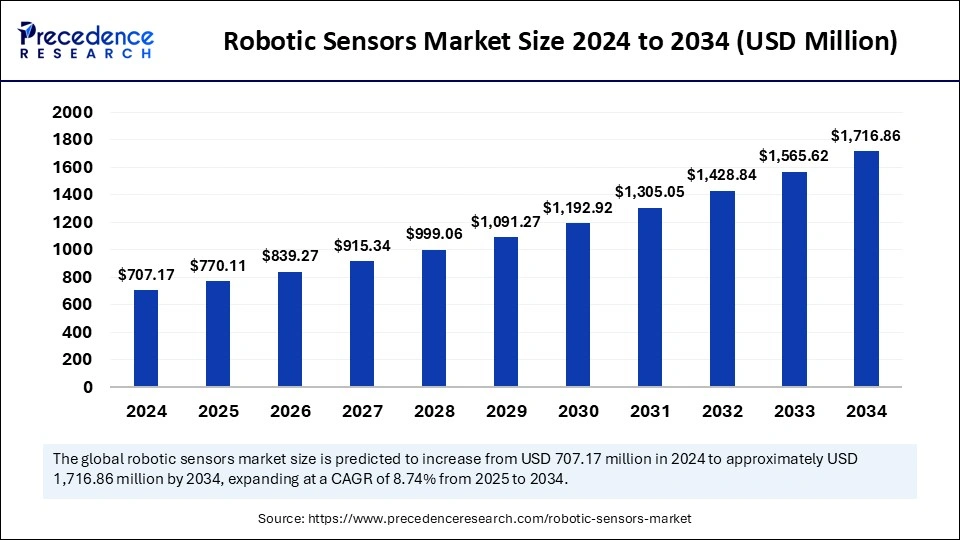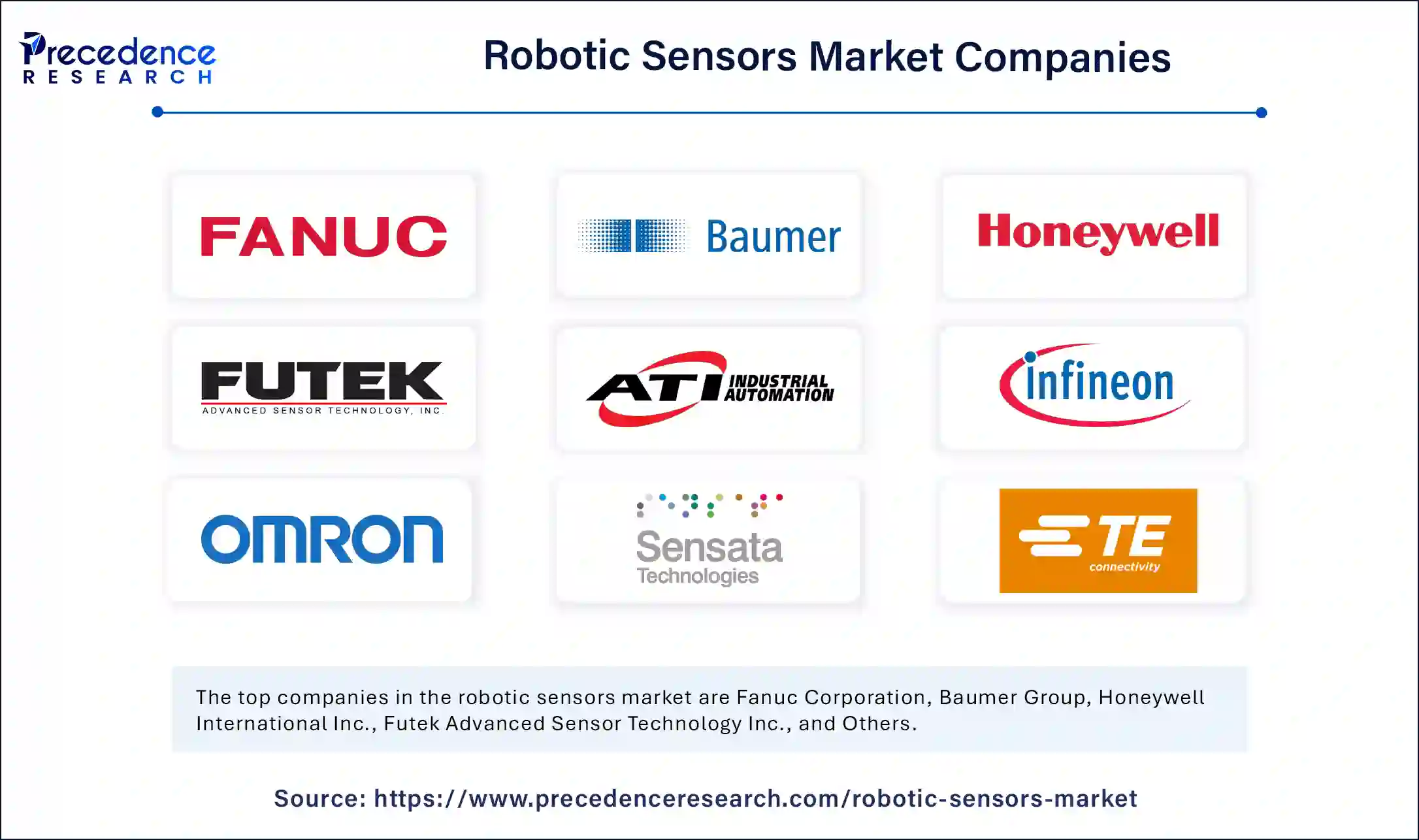August 2024
The global robotic sensors market size is calculated at USD 770.11 million in 2025 and is forecasted to reach around USD 1,716.86 million by 2034, accelerating at a CAGR of 8.74% from 2025 to 2034. The market sizing and forecasts are revenue-based (USD Million/Billion), with 2024 as the base year.
The global robotic sensors market size was estimated at USD 707.17 million in 2024 and is predicted to increase from USD 770.11 million in 2025 to approximately USD 1,716.86 million by 2034, expanding at a CAGR of 8.74% from 2025 to 2034. The growth of the robotic sensors market is driven by the rising adoption of robots in several industries like manufacturing, agriculture, healthcare, and logistics. Furthermore, the increasing integration of AI and IoT with robotics contributes to market growth.

Integration of artificial intelligence (AI) algorithms in robotics is paving the way for the robotic sensors market expansion. Integrating AI in robotics improves accuracy, efficiency, and data-based decision capabilities. AI enables robots to interpret vast amounts of data from sensors, enabling them to perform tasks with great precision. AI-powered robots generate vast amounts of data. This requires advanced sensors to analyze and process the data and enhance the functionality of robots. Algorithms like machine learning allow real-time data analysis, further improving their adaptability in ever-evolving surroundings.
The global robotic sensors market is growing rapidly due to the growing adoption of robotics in various sectors. With the increasing focus on automation, the adoption of robotics has increased in industries like logistics, healthcare, and automotive manufacturing. The increasing focus on enhancing productivity and efficiency in manufacturing processes further contributes to market growth. The rising demand for automation in the logistics and manufacturing sectors is also supporting market expansion. Moreover, technological advances led to the development of 3D sensors and tactile sensors, which further bolster the market. These sensors are improving the performance of robots to seamlessly perform complex tasks with less time consumption.
| Report Coverage | Details |
| Market Size by 2034 | USD 1,716.86 Million |
| Market Size in 2025 | USD 770.11 Million |
| Market Size in 2024 | USD 707.17 Million |
| Market Growth Rate from 2025 to 2034 | CAGR of 8.74% |
| Dominating Region | Asia Pacific |
| Fastest Growing Region | North America |
| Base Year | 2024 |
| Forecast Period | 2025 to 2034 |
| Segments Covered | Sensor Type, Application, Technology, Interface, Platform, and Regions. |
| Regions Covered | North America, Europe, Asia-Pacific, Latin America, and the Middle East & Africa. |
Rising Automation Across Various Industries
The increasing automation across several end-use industries is a major factor driving the growth of the robotic sensors market. The use of robots reduces labor needs and supports automation. As industries seek solutions to automate various tasks while reducing human errors, the adoption of robots increases to boost productivity with precision. This, in turn, boosts the demand for robotic sensors. Industries like manufacturing, healthcare, Defense, and logistics are increasingly incorporating robots into their operations to reduce labor costs. Many industries are shifting toward smart manufacturing, which is expected to drive market growth. With the Industry 4.0 revolution, governments across the globe are investing in automation technologies to expand the nation’s capability in every sector, further driving the market’s growth.
High Costs and Data Security Concerns
Substantial costs required to develop and install robotic sensors hinder the growth of the robotic sensors market. Integrating these sensors into existing systems is complex, creating challenges. Robots that are primarily interconnected with Internet of Things (IoT), AI, and cloud computing continuously generate and gather data from various sensors to work efficiently. However, this raises concerns regarding data security, making it vulnerable to data breaches and fraudulent activities.
Rising Popularity of Robotic Surgery
The rising popularity of robotic surgery is expected to create immense growth opportunities in the robotic sensors market. As the healthcare sector is focusing on automation, the adoption of robots is increasing to automate various tasks, ranging from patient care to surgery. Surgical robots assist surgeons in performing complex surgeries, enhancing accuracy and precision. This, in turn, enhances patient outcomes and reduces recovery time. Surgical robots even perform surgeries without human intervention. Moreover, autonomous robots can be used in hospitals to assist patients who need urgent treatment. As the adoption of surgical robots increases, so does the demand for advanced sensors that can boost the performance of these robots.
Vision sensors play a crucial role in robots. They analyze and process visual data of the environment. These sensors are used in various applications like object recognition, inspection, and navigation. Vision sensors offer various benefits, such as helping produce and process detailed data, and can perform continuous, real-time monitoring. Thus, sectors like automotive, electronics, transportation, and logistics heavily use vision sensors. The rise in the integration of cameras in robots bolstered the segment.
The force/torque sensors segment is projected to grow at the fastest rate in the foreseeable future. The segment growth is attributed to the growing demand for sensors that can offer precise feedback for force in different applications like assembly, surface finishing, and material handling. These sensors enable robots to maintain control over the force they apply during tasks. These sensors are becoming more popular in applications requiring force in a controlled manner. Advanced materials led to the development of more compact and highly efficient force and torque sensors, further fueling the segment’s growth.
The industrial robots segment held the largest share of the robotic sensors market in 2024. This is mainly due to the increase in the deployment of industrial robots to support industrial automation. Industrial robots perform various industry-related tasks faster and more accurately than humans. These robots reduce repetitive tasks. The ongoing revolution of Industry 4.0 and the lack of skilled labor further increased the adoption of industrial robots, supporting segmental growth.
The healthcare robots segment is set to register notable growth in the upcoming period. The segment’s growth can be attributed to the increasing need for assistance in delivering healthcare services. These robots automate various tasks in healthcare organizations, reducing the work burden on healthcare staff. The rising shortage of skilled nurses is expected to boost segmental growth. In addition, the increasing popularity of robotic surgery bolsters the segment.
The MEMS-based segment accounted for the largest market share in 2024. MEMS (microelectromechanical systems) sensors are generally used to detect and measure magnetic fields, which are crucial in navigation, object recognition, and mapping. Their high accuracy and precision make them suitable for robotics.
Traditional technologies used for robotic sensors are more bulky and more complex in terms of processing and physical structure than MEMS technology. Due to high-quality mechanical and electrical assemblies, MEMS-based sensors are highly reliable and durable. Hence, many companies are heavily investing in developing MEMS-based technology, further expanding the segment’s reach.
The optical segment is expected to expand at a significant growth rate in the upcoming period. The segment growth is attributed to the growing demand for high-accuracy and reliable sensors for healthcare applications and industrial automation. Optical sensors are crucial in healthcare and industrial robots. These sensors enable robots to identify objects and navigate precisely. Optical sensors play a critical role in accurately measuring dimensions without physical contact, enhancing performance and efficiency.
The analog segment held the largest share of the robotic sensors market in 2024. Low cost, high accuracy, and less power consumption are key factors boosting the adoption of analog sensors. An analog interface can handle constant signals with high precision and provide high resolution with several possible outcomes. Also, analog systems are more robust and efficient than digital ones. Analog interfaces are widely used in applications where large amounts of data need to be processed with high precision.
The digital segment is anticipated to grow at the highest CAGR during the forecast period. The segment growth is mainly attributed to the enhanced precision and accuracy of these sensors than analog. These sensors are ideal choices for autonomous navigation, object recognition, and precise control of movement. A major benefit of digital interfaces is enhanced user interface experience. A well-established digital interface helps to resolve complex problems in an easy manner, making it more accessible and user-friendly. Additionally, the digital interface acts as a bridge for communication between humans and machines, making it more demanding in the market.
The mobile robots segment held a significant market share in 2024. Mobile robots can work independently without the help of humans, making them an ideal choice for logistics, warehouses, and healthcare. A major benefit of the mobile robot platform includes its design that is compatible with working alongside humans as they are capable of navigating their surroundings to safely avoid obstacles while performing their assigned tasks. This makes mobile robot platforms the ideal option for many end-use industries like manufacturing, construction, and energy, where repetitive tasks need to be performed.
The industrial robots segment is projected to witness notable growth in the coming years. Industrial robots are majorly used in the manufacturing process to automate repetitive tasks with speed and precision. In the industrial sector, heavy-duty tasks need to be performed for maximum output. Hence, these tasks require robots more than humans as they can help save the human workforce and be able to endure stressful jobs without getting injured.
Asia Pacific
Asia Pacific dominated the robotic sensors market with the largest share in 2024. This is mainly due to the rise in the adoption of robotics in industrial automation by countries like China, Japan, and India. These countries are investing heavily in AI-driven robotics due to the evolution of Industry 4.0. There is a heightened adoption of industrial robots in logistics and manufacturing industries. FANUC and Yasakawa are some of the leading robotics manufacturers in the region. Moreover, the rapid expansion of the electronics and automotive sectors further boosts market growth. The rise of AI-driven robotics and a strong emphasis on smart factories further support the market in the Asia Pacific.
Trends in China
The growth of the robotic sensors market in China can be attributed to the government's initiatives like ‘made in China 2025,’ which promotes high-tech manufacturing and automation and helps to build industrial robotics by incorporating technologies like AI and IoT. Also, the rising government investments in R&D to accelerate the development of robot's support market growth.
Trends in India
The robotic sensors market in India is expanding due to increasing automation in various industries, such as healthcare and manufacturing. Rise of industry 4.0 is another factor supporting market expansion. The rising integration of vision sensors and AI in collaborative robots is fueling market growth. There is also heightened adoption of robots in the agriculture sector to automate various repetitive tasks in farming.
North America
North America is expected to observe the fastest growth during the forecast period. The regional market growth is attributed to its robust industrial base with substantial investments in advanced manufacturing technologies and automation. There is a high adoption of robotics in industries like electronics, aerospace, and automotive. Additionally, the region is at the forefront of technological innovations, leading to the development of cutting-edge sensors that align well with AI and robotics applications.
The U.S. is the market frontier due to its established manufacturing, healthcare, and defense sectors. Warehouse automation and the expansion of e-commerce are key factors boosting the market's growth. Various businesses in the U.S. are investing heavily in robotic systems for managing inventories. Moreover, government funding, collaborations between major players, and research initiatives support market expansion.

By Sensor Type
By Application
By Technology
By Interface
By Robotic Platform
By Region
For inquiries regarding discounts, bulk purchases, or customization requests, please contact us at sales@precedenceresearch.com
No cookie-cutter, only authentic analysis – take the 1st step to become a Precedence Research client
August 2024
March 2025
July 2024
January 2025